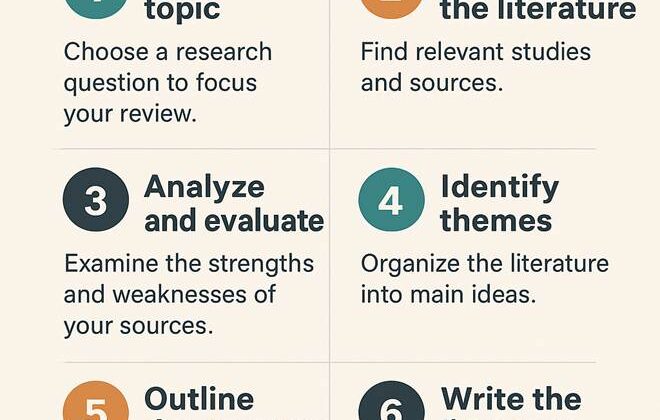
How to Write a Strong Literature Review: A Step-by-Step Guide
How to Write a Strong Literature Review: A Step-by-Step Guide
A literature review is a critical component of academic research, offering a comprehensive analysis of existing studies related to a particular topic. Whether you’re writing for a thesis, dissertation, or research paper, a well-structured literature review demonstrates your understanding of the field, identifies gaps in research, and sets the foundation for your own study.
1. Define Your Research Scope
Before diving into literature, establish clear boundaries for your review:
- Identify the topic: Focus on a specific research question or problem.
- Set criteria for inclusion: Determine which types of studies are relevant (e.g., time period, methodologies, theoretical perspectives).
- Clarify your objectives: Will your review summarize existing research, identify gaps, or compare different approaches?
2. Search and Select Relevant Literature
Gather high-quality sources from credible databases:
- Use academic databases: Google Scholar, PubMed, Scopus, Web of Science.
- Search strategically: Use keywords, Boolean operators, and filters to refine results.
- Evaluate sources critically: Focus on peer-reviewed articles, books, and authoritative reports.
3. Organize and Categorize Your Findings
Once you’ve collected relevant studies, structure your literature review effectively:
- Chronological approach: Present research developments over time.
- Thematic approach: Group studies by recurring themes or trends.
- Methodological approach: Compare different research methods and their findings.
- Theoretical approach: Discuss key theories shaping the field.

4. Analyze and Synthesize Information
A literature review is more than summarizing studies—it requires analysis and synthesis:
- Identify patterns: Highlight common findings, contradictions, or emerging trends.
- Evaluate strengths and weaknesses: Critically assess methodologies and contributions.
- Find research gaps: Where does existing research fall short? What needs further exploration?
5. Write and Structure Your Literature Review
A well-structured review enhances readability and impact:
Introduction
- Define the research topic.
- Explain why the literature review is important.
- Outline how the review is organized.
Body
- Present and analyze literature according to themes, chronology, or methodology.
- Compare findings from different studies.
- Highlight key debates and gaps.
Conclusion
- Summarize key insights.
- Discuss implications for future research.
- Connect findings to your own study.
6. Cite Sources Properly
Academic integrity is crucial—always cite sources accurately:
- Follow citation styles like APA, MLA, Chicago, or IEEE.
- Use reference management tools like Zotero, Mendeley, or EndNote.


